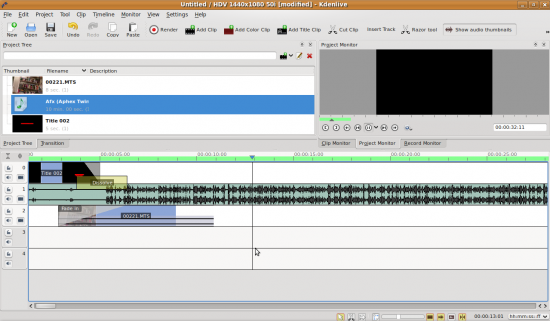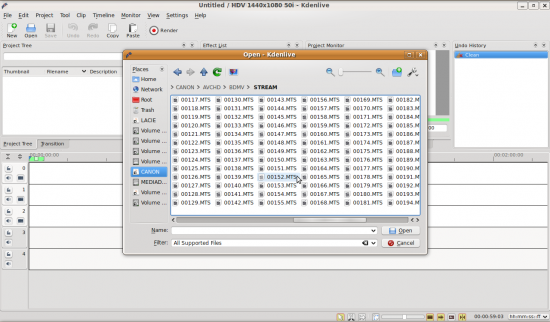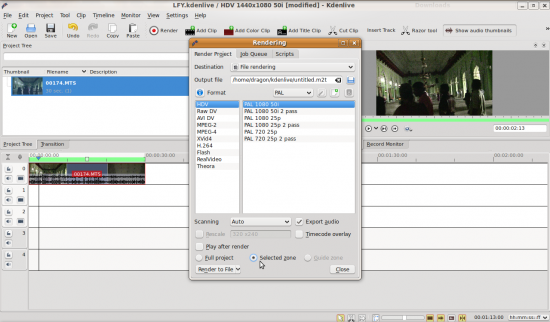As an amateur filmmaker, I have always felt the lack of a powerful and trusted alternative to Final Cut Pro or Sony Vegas on the GNU/Linux platform. There are many solutions, including Cinelerra, Kino, OpenMovie, Kdenlive, etc, but none are mature enough to match their non-free counterparts. Also, they tend to crash frequently, which is unacceptable after you’ve edited a 30-minute clip on the time line. I had stayed away from the slave world of Apple’s Mac and the monopolistic world of Microsoft Windows, but for how long? Then, finally, a few days back I chanced up on Kdenlive again, version 0.7.5, since someone forwarded me a link.
This new version has made me realise that Kdenlive has almost everything that an amateur would want. It may not be as perfect as its proprietary counterparts, but the current release tells us much more about the current attitude within the GNU/Linux world. Ubuntu is almost an equivalent to Windows and Mac for the average user; Firefox is beating IE and Safari badly; Amarok is the best music player around; VLC has no competition whatsoever; then there’s the GIMP, PidGin, Gyachee, and much more. GNU/Linux is like a magician’s hat—it will offer you whatever you ask for. Now, with Kdenlive, one of the missing links is being addressed too.
I tried creating some clips using the new version, and except for a few niceties of its proprietary counterparts (which are a must for any professional), Kdenlive did not disappoint at all. In fact, it impressed me so much that I dropped the idea of buying some creepy machine to run FCP. I trust that within a couple of years, Kdenlive will be much more advanced and can be used ‘freely’.
The time-line of Kdenlive has improved a million times. You can now pull clips like you move a knife through butter (Figure 1). You can add multiple video as well as audio tracks. You can freely move clips from one track to another, as well as to and fro. Kdenlive supports HD video, so it’s actually like taking a walk in the park to import videos directly from my Canon VIXIA HF 11 (Figure 2). However, like any other software—including FCP or Sony Vegas Pro—you can’t play HD-imported video smoothly; you have to first transcode (render) it into the desired AVI format so that you can edit the video. Kdenlive now supports so many formats that you will never have to worry (Figure 3). Once the clip is rendered in the desired format, you can import it again and start editing.



Additionally, you have a rich set of audio/video effects, besides transitions effects. This will enable you to make good quality short films without spending a penny.
Another advantage of using Kdenlive is that you may not have to upgrade your machine. According to the project website, it would work for you if you have a 32- or 64-bit modern processor (AMD64 or Intel mono/dual core systems); a fast hard disc with more than 20 GB of free disc space; a Firewire interface for camcorder capture; at least 1 GB of RAM and a screen size of 1024 x 768 pixels or more.
For advanced use and semi-professional work, Kdenlive recommends investing in a recent computer with AMD Phenom Quad-core processor; 4 GB of RAM; three SATA discs for RAID-5 usage (any Linux distribution offers RAID-5 without an additional controller), and a recent video card with dual display.
Advanced users can stay updated through a very active and supportive forum.
In conclusion, I’d say Kdenlive has now everything an amateur wants, but to become a full-fledged editor there are a few more miles to cover—it’s just a matter of time. It would be great if more users could test Kdenlive and share their experiences with us.




[…] want to subscribe to the RSS feed for updates on this topic.Powered by WP Greet BoxI wrote a quickie on Kdenlive last time and wanted to do a more thorough job this month because this is one killer video editor. […]